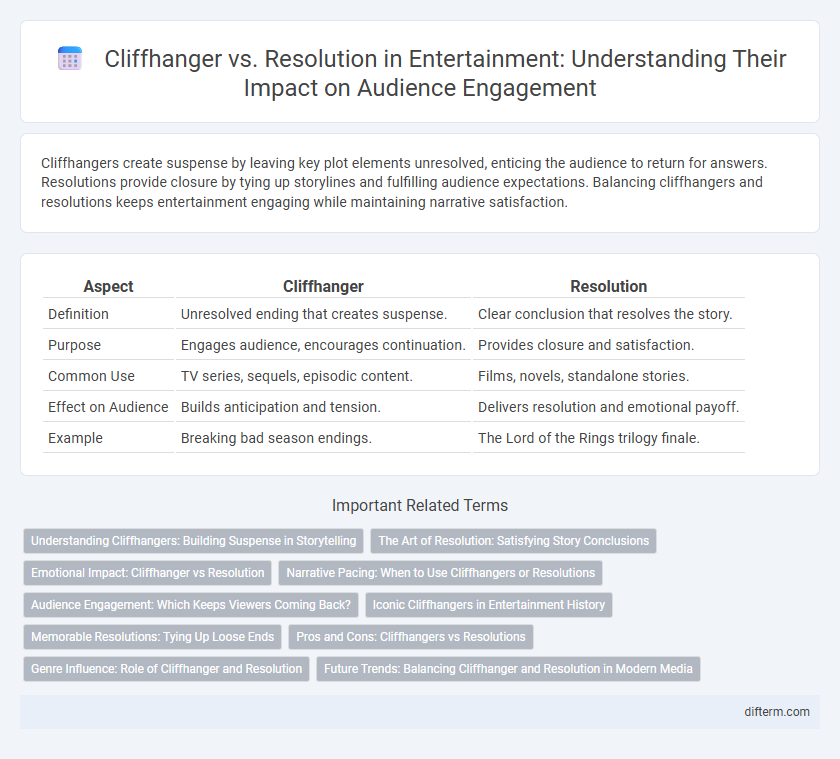Cliffhangers create suspense by leaving key plot elements unresolved, enticing the audience to return for answers. Resolutions provide closure by tying up storylines and fulfilling audience expectations. Balancing cliffhangers and resolutions keeps entertainment engaging while maintaining narrative satisfaction.
Table of Comparison
| Aspect | Cliffhanger | Resolution |
|---|---|---|
| Definition | Unresolved ending that creates suspense. | Clear conclusion that resolves the story. |
| Purpose | Engages audience, encourages continuation. | Provides closure and satisfaction. |
| Common Use | TV series, sequels, episodic content. | Films, novels, standalone stories. |
| Effect on Audience | Builds anticipation and tension. | Delivers resolution and emotional payoff. |
| Example | Breaking bad season endings. | The Lord of the Rings trilogy finale. |
Understanding Cliffhangers: Building Suspense in Storytelling
Cliffhangers create intense suspense by leaving critical plot points unresolved, compelling audiences to eagerly anticipate the next installment. This technique heightens emotional investment and maintains viewer engagement through strategic narrative pauses. Understanding the mechanics of cliffhangers is essential for crafting gripping stories that sustain momentum and viewer interest over time.
The Art of Resolution: Satisfying Story Conclusions
Satisfying story conclusions masterfully resolve narrative tension by addressing key character arcs and plot threads, providing emotional payoff that resonates with audiences. Effective resolutions balance clarity and subtlety, ensuring that major conflicts reach a believable closure without sacrificing complexity. This artful conclusion strengthens overall storytelling, leaving viewers with a sense of completeness and lasting impact.
Emotional Impact: Cliffhanger vs Resolution
Cliffhangers create intense suspense and emotional tension by leaving key plot points unresolved, triggering curiosity and anticipation that keeps audiences engaged. Resolutions deliver emotional payoff and closure, satisfying viewers by resolving conflicts and answering critical questions. The emotional impact of cliffhangers lies in uncertainty and eagerness, while resolutions offer relief and fulfillment.
Narrative Pacing: When to Use Cliffhangers or Resolutions
Narrative pacing in entertainment hinges on strategic use of cliffhangers to sustain audience engagement by creating suspense at critical plot junctures, while resolutions provide emotional closure and satisfy narrative arcs. Cliffhangers are most effective at episode ends or mid-season breaks to encourage return viewership, as seen in series like "Game of Thrones." Resolutions work best in season finales or series conclusions, delivering catharsis and reinforcing character development, exemplified by shows such as "Breaking Bad.
Audience Engagement: Which Keeps Viewers Coming Back?
Cliffhangers create suspense and anticipation, compelling viewers to return to discover the outcome, effectively boosting audience engagement by triggering curiosity and emotional investment. Resolutions provide satisfaction and closure, reinforcing viewer loyalty through a sense of completion and narrative payoff. Effective storytelling balances cliffhangers and resolutions to maintain sustained viewer interest and maximize engagement over time.
Iconic Cliffhangers in Entertainment History
Iconic cliffhangers such as the "Who shot J.R.?" episode from Dallas and the unresolved fate of Sherlock Holmes in "The Final Problem" have defined moments in entertainment history, driving audience engagement and speculation. These suspenseful endings create anticipation that boosts viewership and fan interaction, turning episodes into cultural landmarks. Cliffhangers often become more memorable than the resolutions themselves, shaping the legacy of television and film narratives.
Memorable Resolutions: Tying Up Loose Ends
Memorable resolutions in entertainment effectively tie up loose ends by answering key plot questions and resolving character arcs, providing audiences with a satisfying conclusion. The contrast between a cliffhanger and a resolution lies in closure; cliffhangers create anticipation for future developments, while resolutions deliver definitive endings. Well-crafted resolutions enhance narrative coherence, ensuring viewers leave with a clear understanding of the story's outcome.
Pros and Cons: Cliffhangers vs Resolutions
Cliffhangers captivate audiences by creating suspense and encouraging viewers to return for future installments, enhancing engagement and boosting series longevity. However, overreliance on cliffhangers can frustrate audiences seeking closure and may diminish satisfaction if resolutions are delayed or unsatisfying. Conversely, resolutions provide narrative closure and emotional payoff, satisfying viewers' desire for story completion while potentially reducing anticipation for subsequent content.
Genre Influence: Role of Cliffhanger and Resolution
Cliffhangers are pivotal in genres like thriller and mystery, driving suspense and encouraging continued engagement by leaving key plot points unresolved. Resolutions dominate genres such as drama and romance, providing emotional closure and satisfying narrative arcs that fulfill audience expectations. The strategic use of cliffhangers and resolutions shapes viewer retention patterns and impacts overall storytelling effectiveness across entertainment media.
Future Trends: Balancing Cliffhanger and Resolution in Modern Media
Modern media increasingly balances cliffhangers and resolutions to maintain audience engagement and satisfaction, leveraging data-driven insights to optimize pacing and story arcs. Streaming platforms employ predictive analytics to determine the ideal frequency of cliffhangers, ensuring viewers return while also delivering timely resolutions to avoid frustration. Emerging trends show a shift toward interactive narratives where audience choices influence the balance, enhancing immersion and personalization in entertainment experiences.
Cliffhanger vs Resolution Infographic

 difterm.com
difterm.com